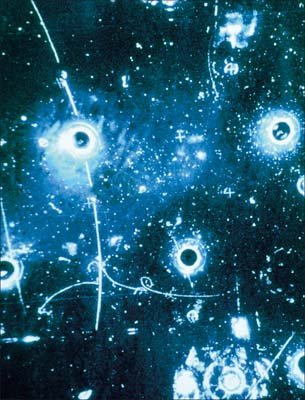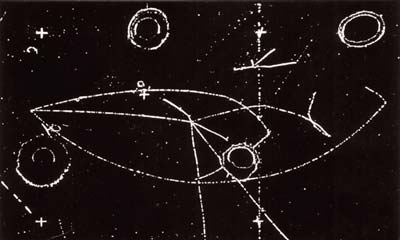A look back to the first observation of weak neutral currents.

On 3 September 1973 the Gargamelle collaboration published two papers in the same issue of Physics Letters, revealing the first evidence for weak neutral currents – weak interactions that involve no exchange of electric charge between the particles concerned. These were important observations in support of the theory for the unification of the electromagnetic and weak forces, for which Sheldon Glashow, Abdus Salam and Steven Weinberg were to receive the Nobel Prize in Physics in 1979. Their theory became a pillar of today’s Standard Model of particles and their interactions, but in the early 1970s, it was not so clear that it was the correct approach and that the observation of neutral currents was a done deal.
The story of the discovery has been told in many places by many people, including in the pages of CERN Courier, notably by Don Perkins in the commemorative issue for Willibald Jentschke, who was CERN’s director-general at the time of the discovery, and more recently in the issue that celebrated CERN’s 50th anniversary, in an article by Dieter Haidt, another key member of the Gargamelle Collaboration (CERN Courier October 2004 p21).
The huge bubble chamber, named Gargamelle after the giantess created 400 years earlier in the imagination of François Rabelais, took its first pictures in December 1970 and a study of neutrino interactions soon started under the leadership of André Lagarrigue. The first main quest, triggered by recent hints from SLAC of nucleon structure in terms of “partons”, was to search for evidence of the hard-scattering of muon-neutrinos (and antineutrinos) off nucleons in the 18 tonnes of liquid Freon inside Gargamelle. Charged-current (CC) events in which the neutrino transformed into a muon would be the key. So the collaboration, spread over seven institutes in six European countries, set to work on gathering photographs of neutrino and antineutrino interactions and analysing them for CC events to measure cross-sections and structure functions.
The priorities changed in March 1972, however, when the collaboration saw first hints that hadronic neutral currents might exist. It was then that they decided to make a two-prong attack in the search for neutral-current (NC) candidates. One line would be to seek out potential leptonic NC events, involving the interaction with an electron in the liquid; the other to find hadronic neutral currents in which the neutrino scattered from a hadron (proton or neutron). In both cases the neutrino enters invisibly, as usual, interacts and then moves on, again invisibly. The signal would be a single electron for the leptonic case, while for hadronic neutral currents the event would contain only hadrons and no lepton (figures 1 and 2).

The leptonic NC channel was particularly interesting because previous neutrino experiments had shown that the background was very small and also because Martin Veltman and his student Gerard ‘t Hooft had recently demonstrated that electroweak theory was renormalizable. ‘t Hooft was able to calculate exactly the cross-sections for NC interactions involving only leptons, with the input of a single free parameter, sin2θw, where θw is the Weinberg angle. Theorists at CERN – Mary K Gaillard, Jacques Prentki and Bruno Zumino – encouraged the Gargamelle Collaboration to hunt down both types of neutral current.
Such leptonic NC interactions would, however, be extremely rare. By contrast hadronic NC events would be more common but it was not yet clear how the theory worked for quarks. In this case the process was not easy to calculate, although Weinberg published some estimates during 1972. In addition there was the problem of a background coming from neutrons that are produced in CC interactions in the surrounding material and could imitate a neutral current signal.
By March 1973 there were as many as 166 hadronic NC candidates
Over the following year various teams carefully measured and analysed candidate events from film produced previously in several runs. The first example of a single-electron event was found in December 1972 by Franz-Josef Hasert, a postgraduate student at Aachen. Fortunately he realized that an event marked by a scanner as “muon plus gamma ray” was in fact something more interesting: the clear signature of an electronic NC interaction written in the tracks of an electron knocked into motion by the punch of the unseen projectile (figure 1). This was a “gold-plated” event because it was found in the muon-antineutrino film in which any background is extremely small. Its discovery gave the collaboration a tremendous boost, strengthening the results that were beginning to roll in from the analyses of the hadronic NC events. However it was only one event, while by March 1973 there were as many as 166 hadronic NC candidates (102 neutrino events and 64 antineutrino events) although the question of the neutron background still hung over their interpretation.
Members of the team then began a final assault on the neutron background, which was finally conquered three months later, as Haidt and Perkins describe in their articles in CERN Courier. On 19 July 1973, Paul Musset presented the results of both hadronic and leptonic analyses in a seminar at CERN. The paper on the electron event had already been received by Physics Letters on 2 July (F J Hasert et al. 1973a); the paper on the hadronic events followed on 23 July (F J Hasert et al. 1973b). They were published together on 3 September.

It was an iconoclastic discovery, leaving many unconvinced. This was mainly because of the stringent limits on strangeness-changing neutral currents and the lack of understanding of the new electroweak theory. Gargamelle continued to increase the amount of data and by the summer of 1974, after the well known controversy described by Haidt and Perkins, several experiments in the US confirmed the discovery. From this time on the scientific community recognized that the Gargamelle Collaboration had discovered both leptonic and hadronic neutral currents.
Thirty-six years later the European Physical Society (EPS) has decided to award its 2009 High Energy and Particle Physics Prize to the Gargamelle Collaboration for the “Observation of weak neutral currents” (Prize time in Krakow at EPS HEPPP 2009). However, it somewhat confounded the collaboration in citing only the authors of the hadronic neutral-current paper, thus neglecting the contributions of the five who signed the electronic paper, but not the hadronic paper (Charles Baltay, Helmut Faissner, Michel Jaffre, Jacques Lemonne and James Pinfold). Though the collaboration is honoured to receive the prize, its members feel that the award should not rewrite history. They feel, and rightly so, that the two papers were of equal importance in the discovery of neutral currents. Also, like many other physicists and the EPS prize committee, they feel that it was perhaps the greatest discovery of CERN. The prize was collected on behalf of the collaboration at the EPS HEP 2009 Conference in Krakow by Antonino Pullia and Jean-Pierre Vialle. Sometime in September the medal will be attached to the Gargamelle chamber, which now stands in CERN’s grounds, and a reunion dinner for the collaboration will follow.





